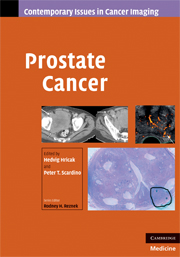Book contents
- Frontmatter
- Contents
- Contributors
- Series Foreword
- Preface
- 1 Anatomy of the prostate gland and surgical pathology of prostate cancer
- 2 The natural and treated history of prostate cancer
- 3 Current clinical issues in prostate cancer that can be addressed by imaging
- 4 Surgical treatment of prostate cancer
- 5 Radiation therapy
- 6 Systemic therapy
- 7 Transrectal ultrasound imaging of the prostate
- 8 Computed tomography imaging in patients with prostate cancer
- 9 Magnetic resonance imaging of prostate cancer
- 10 Magnetic resonance spectroscopic imaging and other emerging magnetic resonance techniques in prostate cancer
- 11 Nuclear medicine: diagnostic evaluation of metastatic disease
- 12 Imaging recurrent prostate cancer
- Index
- Plate section
- References
9 - Magnetic resonance imaging of prostate cancer
Published online by Cambridge University Press: 23 December 2009
- Frontmatter
- Contents
- Contributors
- Series Foreword
- Preface
- 1 Anatomy of the prostate gland and surgical pathology of prostate cancer
- 2 The natural and treated history of prostate cancer
- 3 Current clinical issues in prostate cancer that can be addressed by imaging
- 4 Surgical treatment of prostate cancer
- 5 Radiation therapy
- 6 Systemic therapy
- 7 Transrectal ultrasound imaging of the prostate
- 8 Computed tomography imaging in patients with prostate cancer
- 9 Magnetic resonance imaging of prostate cancer
- 10 Magnetic resonance spectroscopic imaging and other emerging magnetic resonance techniques in prostate cancer
- 11 Nuclear medicine: diagnostic evaluation of metastatic disease
- 12 Imaging recurrent prostate cancer
- Index
- Plate section
- References
Summary
Introduction
Magnetic resonance imaging (MRI) is one of the most useful imaging methods for the non-invasive evaluation of prostate cancer. The prostate and periprostatic structures can be depicted with excellent soft-tissue resolution with MRI, allowing assessment of the local extent of disease. Currently, the role of MRI in prostate cancer is evolving to improve disease detection and staging, to determine the aggressiveness of disease, and to optimize individualized treatment planning and follow-up.
This article reviews the role of MRI in the diagnosis and management of prostate cancer, from diagnosis to post-treatment follow-up. Specific imaging features of prostate cancer as seen on MR imaging are described, and the advantages, limitations, and clinically relevant uses of various MRI techniques are discussed.
Magnetic resonance imaging techniques
A magnetic field strength of at least 1.5 Tesla (T) is required for a high-quality MRI study of the prostate. A magnetic field strength of 3 T provides a greater signal-to-noise ratio that allows higher resolution imaging. The advantages of higher resolution imaging are the detection of small tumors and more accurate local staging.
The use of an endorectal coil with a pelvic phased-array coil markedly improves image quality and is recommended. Magnetic resonance imaging parameters applied in prostate imaging depend on the type of MRI system used and the field strength. In general, T1-weighted transverse images of the entire pelvis are obtained for the assessment of post-biopsy hemorrhage in the prostate, pelvic lymph nodes, and bones.
- Type
- Chapter
- Information
- Prostate Cancer , pp. 140 - 157Publisher: Cambridge University PressPrint publication year: 2008



